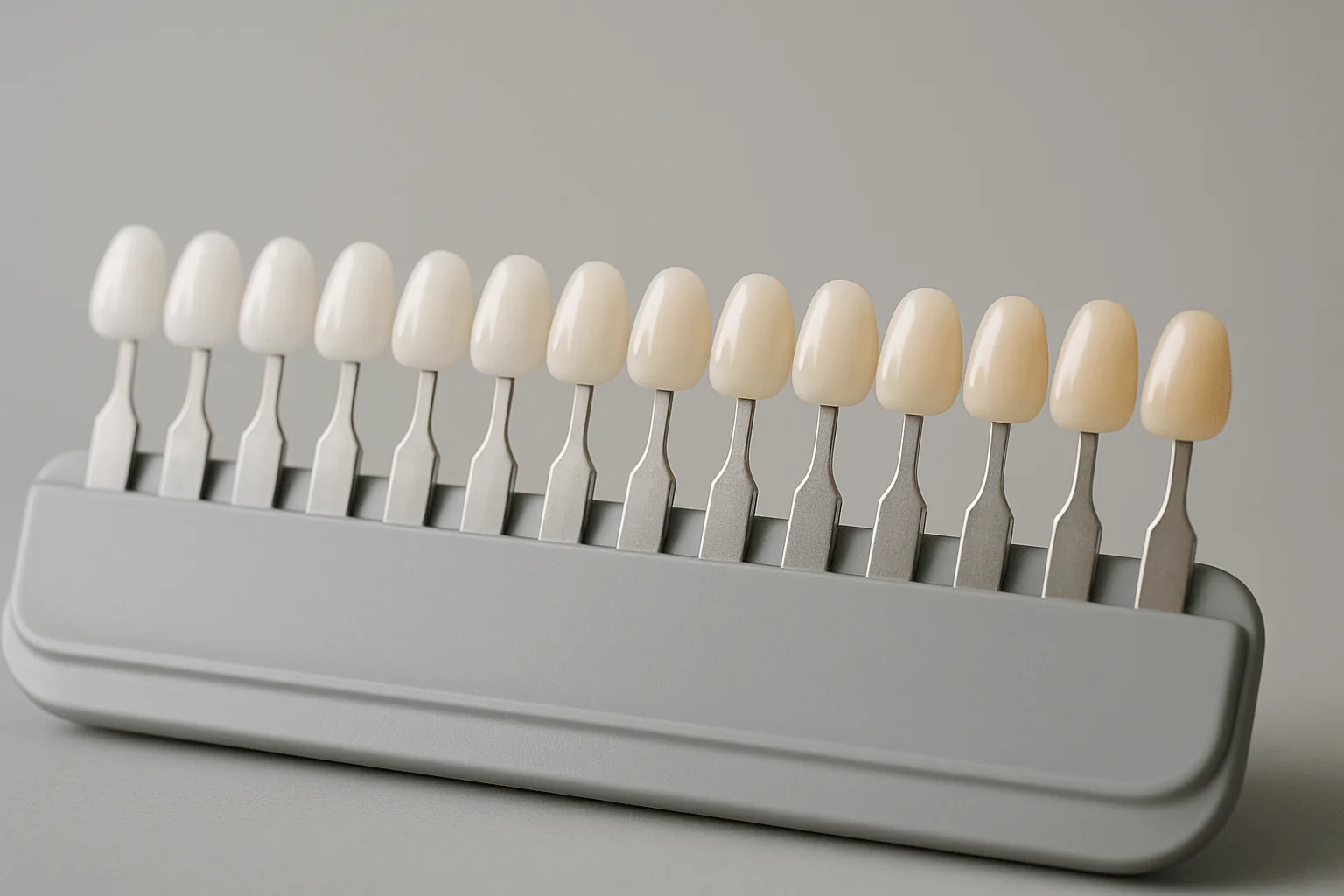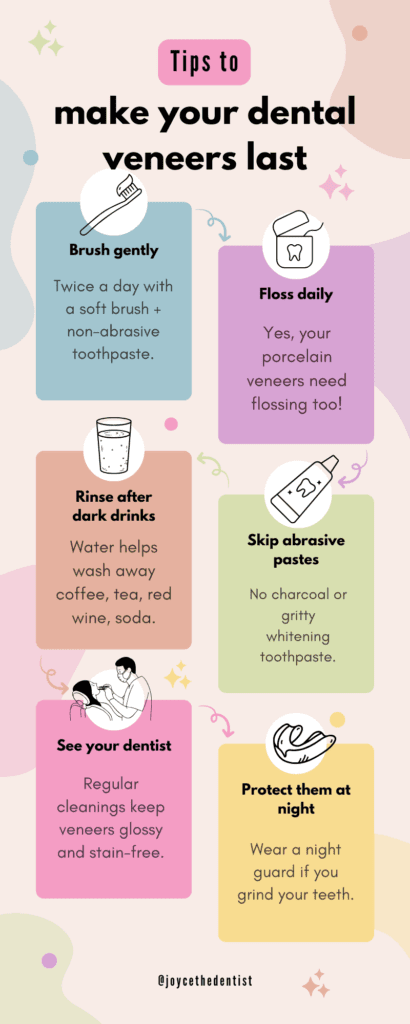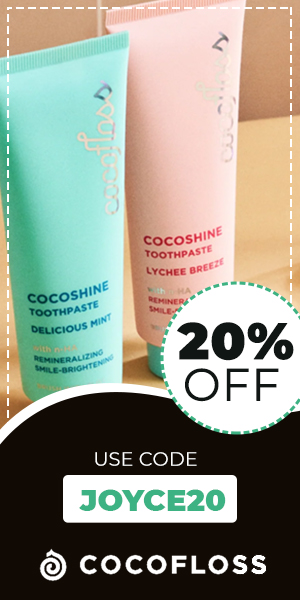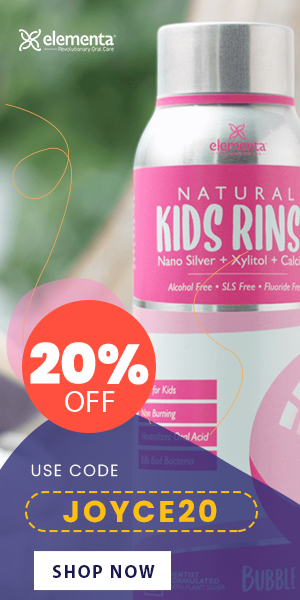Porcelain veneers don’t stain the way natural teeth do.
Because they’re non-porous and finished with a glassy glaze, dark pigments from coffee, tea, or red wine can’t seep in and discolor them.
That said, veneers aren’t completely “stain-proof.” Over time, the edges or the bonding material can pick up color. Habits like using abrasive toothpaste or skipping dental cleanings can dull their shine.
What Makes Porcelain Veneers Stain-Resistant?

Porcelain veneers resist stains because the surface is smooth and glass-like. Pigments from coffee, tea, red wine, or even tomato sauce don’t soak in the way they do with natural teeth.
Your natural enamel has tiny pores and ridges that act like little traps for color, which is why teeth yellow or darken over time.
Porcelain doesn’t have those pores. It’s dense, non-porous, and finished with a protective glaze that helps it stay bright.
It’s also very different from composite resin veneers (aka dental bonding). Composite is more porous, which means it absorbs pigments more easily and tends to stain faster, kind of like fabric versus glass.
This is why porcelain veneers are usually the go-to choice if you want a smile that stays white for the long haul.
Do Porcelain Veneers Discolor Over Time?

Porcelain veneers themselves don’t really change color. They usually stay the same shade for years. What does change is the area around them or the materials that hold them in place.
Here’s where discoloration can show up:
- The natural tooth underneath or beside the veneer can darken, making the veneer look less bright by comparison.
- The bonding resin at the edges may pick up pigments, especially if gums recede over time.
- The surface glaze can wear down if you use abrasive toothpaste, bite your nails, or grind your teeth, which makes veneers look a little duller.
So, while veneers don’t yellow the way natural teeth do, they can look different years down the line. The good news? With the right care and regular dental cleanings, most people keep their veneers looking fresh for a decade or more.

Further reading: What Happens to Teeth Under Veneers?
Can Anything Stain Porcelain Veneers?
Yes. Porcelain is highly stain-resistant, but certain things can still affect how your veneers look.
What can stain or dull veneers:
- Strong pigments that cling to the surface (like turmeric, coffee, red wine, soy sauce)
- Bonding resin at the edges, which absorbs color more easily than porcelain
- Gum recession that exposes the bonding material
- Poor oral hygiene, which accelerates discoloration
The porcelain itself usually stays bright. It’s the surrounding materials and habits that make the difference.
How Fast Do Porcelain Veneers Stain?
Porcelain veneers don’t stain quickly. In fact, a well-made veneer can keep its shade and shine for 10 years or more.
That said, your lifestyle plays a big role. If you’re sipping coffee, tea, or soda all day without rinsing or brushing, you might notice some dullness around the edges in just a few years. The same goes if you use abrasive toothpaste or skip dental cleanings.
So, how long before veneers start looking stained? The porcelain itself stays bright for the long haul, but the bonding edges can discolor sooner if they’re not cared for properly.
Recommended: Best Toothpaste for Veneers in 2025 – Top Picks for a Perfect Smile
Can Stained Veneers Be Whitened?
This is one of the most common questions I get, and the short answer is no, traditional whitening doesn’t work on porcelain veneers.
Whitening toothpaste or strips won’t work
Veneers don’t have pores like natural enamel, so bleach and whitening agents can’t soak in. That means whitening toothpaste, strips, gels, or even in-office bleaching won’t change their color.
So what can help?
- Professional cleaning. Removes surface buildup that makes veneers look dull.
- Polishing in the dental office. Can restore some shine if the glaze is worn.
- Replacing bonding material. If the resin edges have discolored, we can refresh that.
- Replacement veneers. In cases where the veneer itself is damaged or the underlying tooth darkens significantly.
Bottom line: if your veneers look darker or stained, the fix isn’t whitening. It’s cleaning, polishing, or in some cases, replacement.

How Do You Get Stains Out of Porcelain Veneers?
If your veneers are starting to look a little less bright, the good news is that most “stains” are just surface buildup that can be cleaned away.
At home
You can keep veneers looking fresh with simple daily habits:
- Use a soft-bristle toothbrush to avoid scratching the glaze.
- Stick with a non-abrasive toothpaste (skip the charcoal and gritty whitening pastes).
- Rinse with water after drinking coffee, tea, soda, or red wine to wash away pigments before they settle.
- You may use a gentle mouthwash to protect your veneers.
- Floss daily to prevent plaque along the edges where discoloration often starts.
In the dental office
If dullness or staining doesn’t improve at home, a professional cleaning usually does the trick. Dentists can:
- Use ultrasonic cleaning tools to remove buildup.
- Polish veneers with a gentle paste made for porcelain.
- Replace or smooth out the bonding resin if it’s the part that’s stained.
So while you can’t “whiten” veneers the way you can natural teeth, you can restore their brightness with the right care.
How Long Do Porcelain Veneers Last?
On average, porcelain veneers last about 10 to 15 years with good care. I’ve even seen some last well over 20 years when patients protect them and keep up with their dental visits.
Certain habits can shorten their lifespan. Things like teeth grinding, chewing ice, smoking, or sipping dark drinks all day without rinsing. Those don’t just risk staining the bonding edges; they can also wear down or damage the veneer itself.
The good news? High-quality porcelain and strong bonding techniques make veneers both stain-resistant and very durable. With the right routine, they can stay beautiful for a long time.
View this post on Instagram
Quick Care Tips to Keep Veneers Bright
Taking care of veneers isn’t complicated, but consistency makes all the difference. Here are the basics I always remind my patients:
- Brush twice a day with a gentle, non-abrasive toothpaste.
- Floss daily as veneers need flossing just like natural teeth.
- Rinse with water after coffee, tea, red wine, or soda to wash away pigments.
- Skip charcoal or gritty whitening pastes, which can scratch the surface glaze.
- See your dentist regularly for cleanings and checkups.

FAQs About Porcelain Veneers and Stains
Do porcelain veneers discolor?
The porcelain itself doesn’t discolor, but the bonding resin at the edges or the natural tooth underneath can darken over time.
How do you clean veneers?
At home, use a soft brush, gentle toothpaste, and rinse after dark drinks. In the dental office, professional cleaning and polishing can restore brightness.
Can you whiten veneers?
No. Whitening products don’t work on porcelain. The fix is professional cleaning, replacing stained bonding resin, or in some cases, replacing the veneer itself.
How long do porcelain veneers last?
Most last 10–15 years. With excellent care and protection from habits like grinding, some can last 20 years or more.
Do veneers get dull over time?
Yes, the glaze can wear down with abrasive toothpaste or grinding. Your dentist can polish them to bring back the shine.
Do composite veneers stain more than porcelain?
Yes. Composite resin is more porous, so it absorbs pigments faster and stains more easily than porcelain.
What happens if my natural teeth stain but my veneers don’t?
The veneers will stay bright, but your natural teeth may look darker next to them, creating a mismatch. Whitening natural teeth before getting veneers helps prevent this.
Can you replace just one stained veneer?
Yes, but for a seamless color match, dentists often replace veneers in pairs or sets.
Key Takeaways
- Porcelain veneers are highly stain-resistant, but not 100% immune.
- Edge staining or bonding discoloration is more common than surface staining.
- Regular cleanings and gentle at-home care go a long way.
- Whitening products don’t work on veneers. Ask your dentist if you notice changes.
Honestly, veneers are one of the most low-maintenance cosmetic treatments I see in my practice. Patients love how little they stain compared to natural teeth.
But they’re not magic shields. If you take care of them like you would your natural smile (actually, a bit better), they’ll stay gorgeous for years.
If you’re curious about how veneers would hold up with your lifestyle, or if you already have them and notice changes, don’t wait until it bothers you. Check in with your dentist.
And if you want more real-world, expert dental tips, follow me @joycethedentist.





















